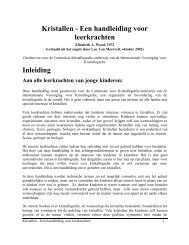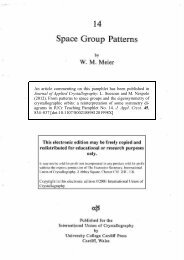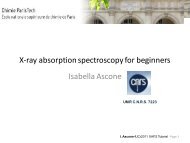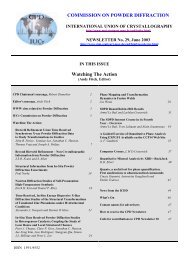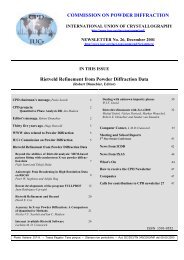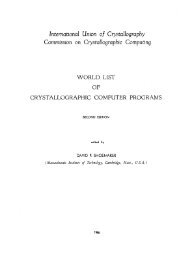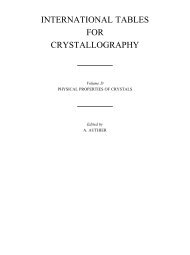Chapter 11: The Growing Field of Mineral Structures - International ...
Chapter 11: The Growing Field of Mineral Structures - International ...
Chapter 11: The Growing Field of Mineral Structures - International ...
You also want an ePaper? Increase the reach of your titles
YUMPU automatically turns print PDFs into web optimized ePapers that Google loves.
CHAPTER<br />
1 I<br />
<strong>The</strong> <strong>Growing</strong> <strong>Field</strong> <strong>of</strong> <strong>Mineral</strong> <strong>Structures</strong><br />
by F. Laves<br />
<strong>11</strong>.1. General Remarks<br />
<strong>Mineral</strong>s are substances <strong>of</strong> either ‘inorganic’ or cmetallic’ character.<br />
From a purely crystallographic point <strong>of</strong> view it would appear unscientific<br />
to prefer minerals to other substances as objects for structure<br />
determination, as minerals are only a chance selection <strong>of</strong> possible<br />
compounds. Thus, it was to be expected that major progress in<br />
‘crystallography’ would be made by people, who did not care whether<br />
the object <strong>of</strong> investigation was a mineral or not. <strong>The</strong> fact that many<br />
mineralogists <strong>of</strong> influence were hesitant to consider structural work on<br />
non-minerals as belonging to the realm <strong>of</strong> mineralogy may be in part<br />
responsible for the present situation, in which crystallography can no<br />
longer be considered a part <strong>of</strong> mineralogy, as it was before 1912.<br />
Crystallography is now a science in its own right with many facets and<br />
roots, mineralogy being only one <strong>of</strong> many others, among them mathematics,<br />
physics, chemistry and biology. Previously it was desirable for<br />
physicists, chemists and biologists to know mineralogy, for it included<br />
an education in crystallography. This situation is well demonstrated by<br />
some sentences von Laue (1943) wrote commemorating the 100th<br />
birthday <strong>of</strong> P. von Groth who was Pr<strong>of</strong>essor <strong>of</strong> <strong>Mineral</strong>ogy and<br />
Crystallography at Munich at the time when von Laue conceived his<br />
idea :<br />
‘Mit Entdeckungen ist es in der Physik-diese im weitesten Sinne<br />
verstanden-eine eigene Sache. In dieser 300 Jahre alten Wissenschaft<br />
ist jeder Entdecker ein Erbe, ein Erbe des geistigen Gutes welches viele<br />
Generationen geschaffen und gemehrt haben. Paul von Groth hat sich<br />
neben vielen anderen grossen Verdiensten such das erworben, dass er die<br />
mehr als lOO-jahrige, anderswo in Deutschland kaum noch vorhandene<br />
Tradition der Raumgitterhypothese in Mtinchen durch seine Lehrtatigkeit<br />
lebendig erhalten und so eine der Voraussetzungen geschaffen<br />
hat, ohne welche die Auffindung der Rontgenstrahlinterferenzen rein<br />
Ghickssache, ihre Deutung ganz unmiiglich gewesen ware.’
THE GROWING FIELD OF MINERAL STRUCTURES 175<br />
Today crystallography is nearly equally needed by mineralogy,<br />
physics and chemistry; conversely mineralogists, physicists and<br />
chemists join in the effort to promote the new science <strong>of</strong> modern<br />
crystallography. From this point <strong>of</strong> view the last fifty years have been<br />
very fateful ones for mineralogy in two respects as far as crystallography<br />
is concerned. <strong>Mineral</strong>ogy lost the field <strong>of</strong> crystallography as its<br />
‘dominated colony’, but it gained from the new possibilities <strong>of</strong> solving<br />
problems <strong>of</strong> central interest to mineralogy.<br />
Before going into details <strong>of</strong> a structural character it should be<br />
mentioned that mineralogy and petrography obtained great advantage<br />
from Laue’s discovery through using the powder method,<br />
invented by the physicists Debye and Scherrer in 1916, for the identification<br />
<strong>of</strong> minerals. Thus it became possible to investigate natural<br />
processes <strong>of</strong> mineral formation, even in those cases where the products<br />
were badly crystallized or microcrystalline. In addition, in many cases<br />
it turned out that substances which were thought to be different<br />
minerals proved to be identical from a structural point <strong>of</strong> view and<br />
vice versa. This is impressively shown in the book by Strunz <strong>Mineral</strong>ogische<br />
Tab&n (1959, 3rd edition). Another application <strong>of</strong> the powder<br />
method <strong>of</strong> steadily increasing importance is the identification, or at<br />
least the characterization, <strong>of</strong> substances produced in experiments<br />
carried out to compare the conditions under which minerals can be<br />
formed in the laboratory with those under which minerals may have<br />
formed in nature.<br />
Two highlights in this respect may be mentioned: (a) the first<br />
artificial production <strong>of</strong> diamond in 1955 ; (b) the production <strong>of</strong> a<br />
previously unknown high-pressure form <strong>of</strong> SiOs by Coes in 1953, later<br />
named coesite. <strong>The</strong> last mentioned discovery is <strong>of</strong> a unique mineralogic<br />
and cosmic interest: after the material was produced in the laboratory<br />
it was looked for in nature and was found as a mineral on the earth’s<br />
surface where giant meteorites had collided with the earth. <strong>The</strong> crystal<br />
structure <strong>of</strong> coesite was determined by Zoltai and Buerger in 1959.<br />
Other important problems are questions <strong>of</strong> nomenclature and <strong>of</strong> the<br />
classification <strong>of</strong> minerals. Crystal structure, structural types and the<br />
rules <strong>of</strong> crystal chemistry became leading principles. P. Niggli’s<br />
textbooks <strong>of</strong> mineralogy (1920, 1924) are milestones in this respect;<br />
they educated and fascinated a generation <strong>of</strong> mineralogists.
176 THE GROWING FIELD<br />
<strong>11</strong>.2. Highlights <strong>of</strong> Structure Determination<br />
Some highlights in determining the important structure types occurring<br />
in minerals shall be mentioned now, regardless <strong>of</strong> whether the determinations<br />
were done by physicists, chemists or mineralogists.<br />
1913 : <strong>The</strong> first structure determinations (W. H. and W. L. Bragg)<br />
were done on the minerals zincblende, diamond and NaCl. It<br />
still appears miraculous to the writer how fortunate and<br />
ingenious the Braggs were in chasing these ‘easy’ substances,<br />
considering how many much more complex structures could<br />
have been picked.<br />
1914: Copper (W. L. Bragg); CaFz (W. L. Bragg); Fess (W. L.<br />
Bragd -<br />
19 15 : Spine1 (Mr. H. Bragg, independently Nishikawa) ; calcite (W. H.<br />
Bw%) -<br />
19 16 : Graphite (Debye and Scherrer ; independently Hull in 19 17) ;<br />
rutile and anatase (Vegard).<br />
1919: Mg(OH)s = CdJs-type (Amin<strong>of</strong>f).<br />
1920: Wurtzite (W. L. Bragg).<br />
1923: NiAs (Amin<strong>of</strong>f).<br />
1924: <strong>The</strong> first silicate, garnet (Menzer).<br />
1925/1926: SiOs - structures (W. H. Bragg and Gibbs; Wyck<strong>of</strong>f;<br />
Seljakow, Strebinski and Krasnikow) .<br />
1923-1926: V. M. Goldschmidt’s famous rules <strong>of</strong> Crystal Chemistry<br />
and the determination <strong>of</strong> the size <strong>of</strong> atoms and ions. <strong>The</strong> main<br />
rule may be quoted here in the original formulation (Geochemische<br />
Verteilungsgesetze der Elemente, VII, pg. 9) :<br />
‘Die Kristallstruktur eines St<strong>of</strong>fes ist bedingt durch Grijsse und<br />
Polarisationseigenschaften seiner Komponenten; als Komponenten<br />
sind Atome (respective Ionen) und Atomgruppen zu<br />
bezeichnen.’<br />
<strong>The</strong> rules were drawn from the results <strong>of</strong> a large amount <strong>of</strong><br />
experimental work gained in cooperation with his coworkers,<br />
mainly Zachariasen and Barth. <strong>The</strong> initial purpose <strong>of</strong> the<br />
work was to get information on the rules which govern the<br />
behaviour <strong>of</strong> matter with respect to isomorphism, isomorphous<br />
exchange, polymorphism and morphotropism. This would be a<br />
basis for investigating the petrological problem <strong>of</strong> the rules<br />
which govern the distribution <strong>of</strong> the elements within the earth<br />
and in its crust. <strong>The</strong> influences <strong>of</strong> V. M. Goldschmidt’s work<br />
on the development <strong>of</strong> mineralogy and crystallography cannot<br />
be overestimated.
THE GROWING FIELD OF MINERAL STRUCTURES 177<br />
1926-1930: Bragg and coworkers (mainly Warren, West and Taylor),<br />
Zachariasen, and Pauling established the principles <strong>of</strong> silicate<br />
structures and their dependence on the Si/O ratio (Si4Or.s<br />
leading to tetrahedral groups; SiaOrs leading to rings or<br />
chains; SiaOrr leading to bands; Si4Ore leading to sheets;<br />
Si4Os leading to frameworks).<br />
1928 : Machatschki recognized that in silicate structures Al can replace<br />
Si; he was able to predict important features <strong>of</strong> the feldspar<br />
structures.<br />
1929: Pauling formulated some very valuable rules for the crystal<br />
chemistry <strong>of</strong> compounds <strong>of</strong> predominantly ionic character.<br />
Whereas these rules are covered in principle by those given by<br />
V. M. Goldschmidt (1926), some <strong>of</strong> them formulate additional<br />
and very important aspects in a precise way. Two are quoted<br />
here in the original:<br />
‘<strong>11</strong>~~ rule, electrostatic valence principle : In a stable coordination<br />
structure the electric charge <strong>of</strong> each anion tends to compensate<br />
the strength <strong>of</strong> the electrostatic valence bonds reaching to it<br />
from the cations at the centers <strong>of</strong> the polyhedron <strong>of</strong> which it<br />
forms a corner; that is, for each anion < = &si.’ [c = charge<br />
<strong>of</strong> the anion; s = z/v; z = charge <strong>of</strong> the cation; v = coordination<br />
number <strong>of</strong> the cation.]<br />
‘III? rule: <strong>The</strong> presence <strong>of</strong> shared edges, and particularly <strong>of</strong><br />
shared faces, in a coordinated structure decreases its stability;<br />
this effect is large for cations with large valence and small<br />
coordination number, and is especially large in case the radius<br />
ratio approaches the lower limit <strong>of</strong> stability <strong>of</strong> the polyhedron.’<br />
[<strong>The</strong> limit <strong>of</strong> stability had been worked out already by V. M.<br />
Goldschmidt in 19261.<br />
1928: In agreement with the rules mentioned before Pauling and<br />
Sturdivant succeeded in an ingenious way in determining the<br />
crystal structure <strong>of</strong> brook&e, the orthorhombic modification <strong>of</strong><br />
TiOs. In addition they were able to give reasons for the<br />
sequence <strong>of</strong> stability <strong>of</strong> the three TiOs-modifications (rutilebrook&e-anatase)<br />
.<br />
1933: Stibnite, SbsSs, and bismuthinite, BisSs (W. H<strong>of</strong>mann).<br />
General rules regarding the crystal chemistry <strong>of</strong> sulpho salts<br />
were given later by Hellner (1958).<br />
1933: W. H. Taylor’s determination <strong>of</strong> the structure <strong>of</strong> feldspars<br />
(refinements are still in progress in the Cavendish Laboratory,<br />
Cambridge, England) may be considered as a most importtna
178 THE GROWING FIELD<br />
step in structural mineralogy, which brought the first period in<br />
this field to a close. An impressive account <strong>of</strong> this period has<br />
been given by W. L. Bragg (1937) in a book Atomic structures <strong>of</strong><br />
minerals. Additional ideas have been put forward by Belov<br />
(1960).<br />
This first period was one in which a large number <strong>of</strong> key structure<br />
types were worked out; these still form the foundations and the<br />
framework <strong>of</strong> the edifice <strong>of</strong> structural mineralogy as far as structural<br />
types are concerned. It is a large edifice with much room for many<br />
research workers to put walls and windows in the right places and to<br />
decorate the rooms with the beauty <strong>of</strong> further research results in<br />
structural mineralogy.<br />
In one respect this ‘edifice’ seems to be different from those accomodating<br />
the results <strong>of</strong> structure research on substances produced<br />
artificially. In structural mineralogy the architectural style is restricted<br />
by the fairly small number <strong>of</strong> building stones <strong>of</strong>fered in nature. In the<br />
fields <strong>of</strong> inorganic and organic chemistry, however, the human spirit<br />
may continuously produce new materials under varying conditions<br />
differing from those in nature. Thus in these other fields the style may<br />
be changed to adjust itself to new developments in building materials<br />
from year to year.<br />
This simile should not be taken as indicating that in the writer’s<br />
opinion structural mineralogy is doomed to reach a state <strong>of</strong> stagnation.<br />
<strong>The</strong> opposite is the case due to the fact that no crystal is perfect. <strong>The</strong><br />
degree <strong>of</strong> perfection (respectively imperfection) can differ both in<br />
different mineral species and in d.i.%erent specimens <strong>of</strong> the same species.<br />
<strong>The</strong> kind and degree <strong>of</strong> imperfection may be rather significant for the<br />
question <strong>of</strong> mineral and rock genesis. <strong>The</strong>refore, the study <strong>of</strong> mineral<br />
imperfections is not only fascinating as a research object <strong>of</strong> crystallography,<br />
but the results <strong>of</strong> such studies will be important for general<br />
mineralogy and petrology.<br />
Some examples may be discussed in this respect following a historical<br />
order.<br />
<strong>11</strong>.3. Point Defect<br />
<strong>Mineral</strong>s are usually formed from solutions (magmatic or hydrous)<br />
containing many elements which are not needed for the mineral<br />
formation, but which become incorporated in the crystal. <strong>The</strong> question<br />
<strong>of</strong> how this incorporation can occur (and mostly does occur) was
THE GROWING FIELD OF MINERAL STRUCTURES 179<br />
already answered by Vegard in 1917. He found random distribution <strong>of</strong><br />
different kinds <strong>of</strong> atoms on identical lattice points and a change <strong>of</strong><br />
lattice constants nearly proportional to the amount <strong>of</strong> incorporated<br />
material (‘Vegard’s law’). Deviations <strong>of</strong> this ‘Law’ are <strong>of</strong> special<br />
interest nowadays. V. M. Goldschmidt (1926, pg. 83) investigated the<br />
question <strong>of</strong> how different the sizes <strong>of</strong> atoms or ions may be so that<br />
substitution can still occur. He gave the empirical rule:<br />
‘Tsomorphe Mischbarkeit in erheblichem Ausmasse und bei<br />
Temperaturen, welche nicht sehr nahe dem Schmelzniveau<br />
liegen, tritt ein, wenn die Radien der betreffenden Bausteine<br />
urn nicht mehr als etwa l.!i”!Jo (in Prozenten des kleinsten<br />
Radius) voneinander verschieden sind.’ (For more details on<br />
this statement see the original paper.)<br />
Hume-Rothery and coworkers (1934) showed that a similar rule holds<br />
for solid solutions in metals.<br />
Another kind <strong>of</strong> more or less randomly distributed point defect<br />
(now called ‘Leerstelle’ or ‘vacancy’) was first described by Laves<br />
(1930) to explain the ‘excess’ <strong>of</strong> sulphur usually found in natural<br />
‘FeS’. He proposed the formula Fe,-& instead <strong>of</strong> Fe,&,+l. Barth and<br />
Posnjak (1931) introduced the concept <strong>of</strong> ‘variate atom equipoints’ in<br />
discussing the imperfections in spine1 and other structures, and Hagg<br />
(1933) distinguished between ‘substitution, addition and subtraction<br />
mixed crystals’.<br />
<strong>11</strong>.4. Felds~ars<br />
This concept led Barth (1934) to a hypothesis which turned out to be<br />
one <strong>of</strong> the most important ideas in the advance <strong>of</strong> mineralogy and<br />
petrology, if feldspars are considered as important minerals. He<br />
explained the different symmetries <strong>of</strong> potassium or K-feldspars<br />
(optically monoclinic sanidine and optically triclinic microcline) on<br />
the assumption that Al and Si may be disordered (as ‘variate atom<br />
equipoints’) in sanidine and ordered in microcline. This new hypothesis<br />
contradicted an older one advanced by Mallard (1876), who<br />
considered optically monoclinic K-feldspar to be the same ‘phase’ as<br />
triclinic microcline; the true symmetry <strong>of</strong> the latter would not be<br />
recognizable optically owing to submicroscopical twinning. <strong>The</strong><br />
decision between these hypotheses was not possible, however, as long<br />
as the triclinic character <strong>of</strong> microcline had not been established by<br />
X-rays. In those days (Barth, 1928) no differences in geometry
180 THE GROWING FIELD<br />
between the two lattices had been observed. <strong>The</strong> problem was taken up<br />
again in 1950 and 1952 by Laves. It could be shown that (a) many<br />
microclines have a small but significant deviation from monoclinic<br />
geometry, M. = 90.5” and y = 92.5”, later called ‘maximum microcline’<br />
; (b) microcline is usually twinned polysynthetically after a<br />
combination <strong>of</strong> two twin laws, which fact is understandable if microcline<br />
was once monoclinic; (c) some optically monoclinic K-feldspars<br />
show the same kind <strong>of</strong> microcline twinning when X-rayed; (d) there<br />
are states with deviations from monoclinic symmetry which lie<br />
between those <strong>of</strong> maximum microcline and a = y = 90”, later called<br />
‘intermediate microcline’ ; (e) many hkl and hkl reflections show<br />
significant differences in intensity, the differences being larger for<br />
maximum microcline than for material with intermediate deviations<br />
from monoclinic geometry; (f) there are optically monoclinic K-<br />
feldspars with sharp reflections in monoclinic positions plus diffuse<br />
tails which have shapes and intensity distributions which can best be<br />
explained by the submicroscopical twinning <strong>of</strong> domains <strong>of</strong> triclinic<br />
character with atomic arrangements approaching those <strong>of</strong> intermediate<br />
or maximum microcline. Such material was called ‘orthoclase’<br />
to distinguish it from sanidine which does not show these tails and<br />
which appears to be truly monoclinic-not only optically but also<br />
when investigated by X-rays; (g) in addition to the tails mentioned in<br />
(f) many ‘orthoclases’ show diffuse reflections in positions not consistent<br />
with the feldspar lattice proposed by Taylor (1933). A qualitative<br />
model explaining these reflections was given in 1961 (Laves and<br />
Goldsmith; J. V. Smith).<br />
With these observations (a-f) it could be proved that there are at<br />
least two K-feldspar modifications: monoclinic sanidine and triclinic<br />
microcline, thus supporting Barth’s (1934) hypothesis; that there are<br />
optically monoclinic K-feldspars with a structural appearance supporting<br />
Mallard’s hypothesis (1876); and that there are K-feldspar<br />
states, which may not be considered as stable phases in the sense <strong>of</strong><br />
Gibbs, which are neither sanidine nor microcline but something in<br />
between. Such material was called common or normal orthoclase or<br />
just ‘orthoclase’. <strong>The</strong>re is still much discussion nowadays between<br />
crystallographers and mineralogists on the significance and characterization<br />
<strong>of</strong> such K-feldspar states which can be considered neither as<br />
sanidine nor as microcline as a consequence <strong>of</strong> structural imperfections<br />
which show themselves in X-ray photographs as described above in<br />
(f) and (g). <strong>The</strong> present situation is expressed in a paper given by<br />
Laves and Goldsmith at a feldspar symposium sponsored by the
THE GROWING FIELD OF MINERAL STRUCTURES 181<br />
<strong>International</strong> <strong>Mineral</strong>ogical Association in Copenhagen in 1960<br />
entitled ‘Polymorphism, order, disorder, diffusion and confusion in the<br />
feldspars’. Other papers and discussions on the subject by R. B. Ferguson,<br />
J. B. Jones, W. S. Mackenzie, A. S. Marfunin, H. D. Megaw, J. V.<br />
Smith, W. H. Taylor are compiled in the Proceedings <strong>of</strong> this meeting<br />
(CursiZZos y Conferencias Vol. 8, September 1961, Instituto ‘Lucas<br />
Mallada’, Madrid), which in addition contains many other important<br />
papers by Megaw and coworkers on structural features <strong>of</strong> the plagioclases<br />
which will not be discussed here in detail. <strong>The</strong> papers <strong>of</strong> this<br />
Conference show in an impressive way the lively activity <strong>of</strong> crystallographers<br />
and mineralogists in using X-rays for the solution <strong>of</strong> the<br />
problems and puzzles which nature has <strong>of</strong>fered through the production<br />
<strong>of</strong> feldspars. Much has been done but more is needed in order to<br />
understand the complexities involved.<br />
<strong>The</strong> feldspars are treated here in great detail for three reasons : (1) <strong>The</strong><br />
problems involved are typical <strong>of</strong> the difficulties mineralogy has to put<br />
up with. <strong>The</strong>se difficulties are such that it appears to be impossible to<br />
reproduce in the laboratory the conditions under which some minerals<br />
were formed, because we may vary in the laboratory the pressure and<br />
temperature and the chemical compositions <strong>of</strong> our reaction products<br />
but we cannot compete with the time nature had available. All<br />
attempts to synthesize the ordered low-temperature modifications <strong>of</strong><br />
K-feldspar (microcline) and Na-feldspar (albite) failed. <strong>The</strong> products<br />
have been always disordered high-temperature modifications. On the<br />
other hand it is easy to produce disordered high-temperature modifications<br />
by heating the ordered low-temperature modifications to near<br />
the melting point. (2) <strong>The</strong> feldspars <strong>of</strong>fer an excellent example <strong>of</strong> the<br />
central question in mineralogy and crystallography: What is a mineral,<br />
what is a single crystal, a question which is not only one <strong>of</strong> semantics<br />
but involves interesting problems <strong>of</strong> the nature <strong>of</strong> the condensed state<br />
currently discussed. (3) Besides quartz the feldspars are the most<br />
frequent minerals as together they make up approximately 65% <strong>of</strong> the<br />
earths crust.<br />
Returning to Barth’s Al/Si order/disorder hypothesis the question<br />
arises <strong>of</strong> how can it be proved? <strong>The</strong> scattering powers <strong>of</strong> Al and Si are<br />
so similar that it is impossible to decide by X-rays whether a particular<br />
site is occupied by Al or Si except perhaps by methods not yet easily<br />
feasable. For this reason Taylor gave in 1933 only the sites where Al or<br />
Si are located. <strong>The</strong>refore, other methods had to be tried for information<br />
on the Al/Si order and disorder. <strong>The</strong>y are summed up in short. (a) By<br />
diffusion experiments near the melting point the Na <strong>of</strong> an albite could
182 THE GROWING FIELD<br />
be replaced by K leading to microcline (Laves, 1951). This indicated<br />
that the alkali ions are not responsible for the differences between the<br />
high and low-temperature forms and that the differences must lie in<br />
the AlSisOs framework. It was proved further that the Al/% distribution<br />
<strong>of</strong> albite and microcline are identical. Very accurate structure<br />
determinations <strong>of</strong> albite and maximum microcline are now at hand<br />
(unpublished work by S. W. Bailey, personal communication) which<br />
are in line with this. (b) It can be shown theoretically that mechanical<br />
twinning cannot take place if the Al/Si distribution is ordered but it<br />
may take place if it is disordered. Experiments to twin albite mechanically<br />
failed (Miigge and Heide, 1931) even under extreme<br />
conditions, but mechanical twinning can easily be performed at room<br />
temperature (Laves, 1952) with Na-rich feldspars if they are in a<br />
high-temperature state. (c) Results <strong>of</strong> crystal chemistry gained from<br />
substances other than feldspar suggested that the size <strong>of</strong> (Al,Si)Oa<br />
tetrahedra should be approximately proportional to the probability<br />
<strong>of</strong> an Al sitting in the tetrahedra (J. V. Smith, 1954). A refined<br />
structure determination <strong>of</strong> a halfway intermediate microcline (Bailey<br />
and Taylor, 1955) revealed significant differences in size between the<br />
four tetrahedral sites. (<strong>The</strong>se results should be compared with those <strong>of</strong><br />
a structure determination <strong>of</strong> an ‘orthoclase’ carried out by Jones and<br />
Taylor in 1961.) <strong>The</strong> same was true in a refined structure determi.-<br />
nation <strong>of</strong> albite (Ferguson, Trail1 and Taylor, 1958). <strong>The</strong> refined<br />
structure determination <strong>of</strong> NaAlSisOs in a high-temperature state,<br />
carried out with the same accuracy by the same authors did not<br />
reveal any differences in the sizes <strong>of</strong> the tetrahedra. (d) <strong>The</strong> difference<br />
in the sharpness <strong>of</strong> infrared absorption bands between low and hightemperature<br />
forms strongly indicates differences in the degree <strong>of</strong><br />
Al/Si order (Laves and Hafner, 1956 and 1957): (e) Finally, measurements<br />
<strong>of</strong> the nuclear magnetic resonance <strong>of</strong> KAlSisOs and NaAlSisOs<br />
in the low and high-temperature state leave no doubt, that the Al/Si<br />
order is practically complete in microcline and albite, whereas it is<br />
practically zero in the corresponding high-temperature states (Brun,<br />
Hafner, Hartmann and Laves, 1960).<br />
<strong>The</strong> account given above shows that sometimes the combination <strong>of</strong><br />
different approaches -field evidence, good ideas (Barth), accurate<br />
structure determinations (Taylor and coworkers) and physical<br />
methods other than X-ray investigations-is necessary if problems<br />
are to be solved which are <strong>of</strong> pertinent interest to mineralogy and<br />
petrology.
THE GROWING FIELD OF MINERAL STRUCTURES 183<br />
<strong>11</strong>.5. One-dimensional Disorder (Stacking Faults) and Polygbism<br />
In the above section some diffuse reflections were mentioned which<br />
occur in X-ray photographs <strong>of</strong> feldspars; these have not yet been<br />
explained rigorously by mathematical treatment. Thus, there is still<br />
much to be done in the future. However, somewhat similar effects have<br />
been observed in other minerals which could be treated mathematically<br />
in a more rigorous way: stacking faults. <strong>The</strong> first observation <strong>of</strong> this<br />
kind was published in 1927 by Mauguin who observed ‘streaks’<br />
corresponding to rows in reciprocal space in X-ray photographs <strong>of</strong><br />
micaceous minerals. Similar effects were observed by Nieuwenkamp<br />
and Laves (1935) in X-ray photographs <strong>of</strong> maucherite, NisAs2, and <strong>of</strong><br />
SiOs. Hendricks and Teller (1942) added much to the theoretical<br />
interpretation <strong>of</strong> these effects in the case <strong>of</strong> the mica minerals and<br />
A. J. C. Wilson (1942) in the case <strong>of</strong> metals and alloys. Jagodzinski<br />
and Laves (1949) introduced the concept <strong>of</strong> ‘eindimensionale Fehlordnung’<br />
(one-dimensional disorder) having observed similar effects<br />
in single crystals <strong>of</strong> graphite and ZnS. <strong>The</strong> most general theoretical<br />
treatment <strong>of</strong> the observed X-ray effects has been given by Jagodzinski<br />
(1949) ; he considered the influence <strong>of</strong> the position <strong>of</strong> a given layer<br />
on the position <strong>of</strong> other layers up to four layers away. As umdirectional<br />
stress can change the order-disorder relations (for example, it is<br />
possible experimentally to produce ‘rhombohedral graphite’ domains<br />
within a single crystal <strong>of</strong> hexagonal graphite) applications <strong>of</strong> such<br />
investigations to the geological history <strong>of</strong> mica and other sheet minerals<br />
in rocks may become important for future studies <strong>of</strong> rock metamorphism.<br />
An important example for such polymorphism or polytypism which<br />
is chemically simple and has mineralogical interest is ‘tridymite’, a<br />
‘polymorph’ <strong>of</strong> SiOz. If we consider the tridymite structure as it is<br />
given in textbooks it can be described in some analogy to the hexagonal<br />
close-packed structure with a sequence <strong>of</strong> layers ABAB . . . If we call<br />
this a 2-layer sequence, structural work has shown that no tridymites<br />
are known yet which have such an ideal e-layer sequence. Mistakes<br />
occur which necessitate the consideration <strong>of</strong> an additional C position<br />
in such a way that ABC-sequences must be present. Buerger and<br />
Lukesh (1942) observed natural tridymites with n-layer sequences<br />
with n = 10 or 20. Flijrke (1955) found the same sequences in tridymites<br />
produced synthetically; other kinds <strong>of</strong> stacking disorder<br />
within single crystals were found by him too. Whereas some correlations<br />
between layer sequence and impurities could be worked out,
184 THE GROWING FIELD<br />
the reasons for the preference for lo- and 20-layer sequences are still<br />
obscure, Several authors discussed similar structural anomalies<br />
observed in Sic where n-layer sequences up to n = 594 and more are<br />
reported in the literature (Mitchell, 1958). For a discussion <strong>of</strong> the<br />
reasons for such large periodicities perpendicular to the layer plane a<br />
paper by Jagodzinski and Arnold (1960) may be quoted. Jagodzinski<br />
rejects the opinions advanced by such authors as Bhidde, Verma and<br />
Mitchell suggesting that the polytypes are caused by screw dislocations<br />
and proposes that the influence <strong>of</strong> entropy terms may be more<br />
important. However, his concluding sentence reads ‘A great deal <strong>of</strong><br />
effort is needed to solve these problems’.<br />
<strong>11</strong>.6. What is a <strong>Mineral</strong>? What is a Crystal?<br />
<strong>The</strong> writer as a pr<strong>of</strong>essor <strong>of</strong> mineralogy has frequently been asked<br />
‘What is mineralogy. 3’ An answer like ‘it is the science which deals<br />
with minerals’ can easily be given; some people however, are not<br />
content with such an answer and want to know ‘What are minerals?’<br />
At this point it is better to leave the room, for there is no satisfactory<br />
answer to such a question. Here are the problems.<br />
Looking into textbooks <strong>of</strong> mineralogy one finds (neglecting such<br />
3ninerals as amber and others) that a mineral is an inorganic substance<br />
produced by natural processes, implying in this context that<br />
processes in which men are involved are considered unnatural.<br />
Furthermore ‘homogeneity’ is one <strong>of</strong> the properties which belongs to a<br />
mineral.<br />
However, what does ‘homogeneous’ mean? This question could not<br />
be answered in a satisfactory way before 1912, nor can it be answered<br />
today as we shall see. Thus it may appear that the new tool available<br />
since Laue’s discovery has not helped us to answer this basic question<br />
<strong>of</strong> mineralogy. In a strict sense this is true. However, in many special<br />
cases X-rays can tell us that substances ,previously thought to be<br />
homogeneous are actually mixtures <strong>of</strong> different substances; in other<br />
cases X-rays have revealed structural features in ‘minerals’ which are<br />
fascinating and which add considerably to the liveliness <strong>of</strong> the present<br />
day research in structural mineralogy.<br />
One example may be given for illustration. Moonstone, a gemstone<br />
with beautiful blue schiller belonging to the feldspar group, can be<br />
considered as creally’ being homogeneous when in a high-temperature<br />
state, i.e. for example when formed under magmatic conditions.
THE GROWING FIELD OF MINERAL STRUCTURES 185<br />
However, when we pick up such a feldspar in nature it usually has a<br />
low temperature and may have changed considerably in its atomic<br />
arrangement during the millions <strong>of</strong> years which may have elapsed<br />
since it was formed.<br />
Neglecting minor impurities always present in each ‘pure’ substance<br />
the chemical composition <strong>of</strong> the feldspars can be expressed as a<br />
mixture <strong>of</strong> three ‘molecules’ Or = KAlSisOs, Ab = NaAlSisOs,<br />
An = CaAlsSisOs. Moonstone, an alkali feldspar, is a mixture <strong>of</strong> the<br />
molecules Or and Ab and usually appears ‘homogeneous’ when<br />
investigated with a microscope.<br />
X-ray photographs, however, give results which can be interpreted<br />
as a single-crystal pattern <strong>of</strong> ‘orthoclase’ or sanidine (KAlSisOs) plus<br />
oriented reflections, more or less diffuse, in positions which correspond<br />
approximately to those positions which a pure but twinned NaAlSisOs<br />
would show when X-rayed alone (either in the low-temperature form<br />
albite or in the high-temperature form analbite or in an intermediate<br />
state between albite and analbite).<br />
<strong>The</strong> conclusion may be that moonstone is not a mineral but a<br />
mixture <strong>of</strong> minerals. Considering that the K and Na-rich areas cannot<br />
be discriminated by microscopic investigation but that their existence<br />
can be shown by X-rays, and considering that the size and shape <strong>of</strong><br />
these areas changes from specimen to specimen (as revealed by the<br />
varying diffuseness and position <strong>of</strong> the Na-feldspar reflections) the<br />
question 3nineral’ or ‘not-mineral’ finally boils down to a question<br />
similar to ‘has a Texas Grapefruit a yellow or an orange colour?’<br />
Thus, trying to answer the question ‘What is a mineral’ leads to the<br />
question ‘What does homogeneous mean?’ Through trying to answer<br />
this question, theoretical problems <strong>of</strong> high importance arise which are<br />
<strong>of</strong> general interest not only for mineralogy but also for the theory <strong>of</strong> the<br />
condensed state in its broadest sense. <strong>The</strong> problems involved have not<br />
yet been solved, but X-ray investigations <strong>of</strong> minerals <strong>of</strong>fer excellent<br />
examples for future discussion <strong>of</strong> the kinetics and thermodynamics <strong>of</strong><br />
solid-state reactions.<br />
As one <strong>of</strong> these examples moonstone has been mentioned already.<br />
For further discussion it is chosen again for several reasons. It belongs<br />
to the group <strong>of</strong> feldspars which are a major component <strong>of</strong> the earth<br />
(appr. 65%). Th us, it occurs in many localities and there is a good<br />
opportunity to study and to compare samples <strong>of</strong> different origin on the<br />
one hand, and to compare the structural states (there is no one state<br />
characteristic <strong>of</strong> the moonstone) <strong>of</strong> moonstones with the structural<br />
states <strong>of</strong> other feldspars which are chemically alike.
186 THE GROWING FIELD<br />
As a result <strong>of</strong> such investigations we now know that feldspars with<br />
moonstone composition can exist in an infinite number <strong>of</strong> different<br />
states. <strong>The</strong>se states lie between two extremes. (1) An ideal homogeneous<br />
mineral in which the alkali sites <strong>of</strong> the crystal structure are<br />
randomly occupied by K and Na ions and in which structural sites<br />
exist which are occupied nearly at random by Al and Si ions. (2) An<br />
ideal mixture (called perthite) <strong>of</strong> two ideal homogeneous minerals,<br />
namely microcline and albite, both having structural sites which are<br />
occupied either by Al or by Si ions. In microcline the alkali sites are<br />
occupied only by K ions, in albite only by Na ions. Thus, after the<br />
crystallization <strong>of</strong> a feldspar with moqnstone composition processes<br />
may take place concurrently during geological times within a morphological<br />
unit: (a) separation into areas <strong>of</strong> different K/Na ratio, (b)<br />
change <strong>of</strong> the original Al-Si disorder into states <strong>of</strong> higher order, (c)<br />
enlargement <strong>of</strong> the Na-rich and K-rich areas by a process <strong>of</strong> ‘recrystallization’<br />
into areas <strong>of</strong> a visible size.<br />
Whether the state, stable at ‘room temperature (microcline plus<br />
albite), is fully reached by these processes or only partly approached<br />
may depend on several factors, some among them <strong>of</strong> geological<br />
character. Thus a morphological unit <strong>of</strong> one typical mineral (sanidine)<br />
may change continuously into a material <strong>of</strong> two typical minerals<br />
(microcline and albite) which can easily be separared mechanically.<br />
At which stage does such a morphological unit cease to be one mineral<br />
and become a mixture <strong>of</strong> two minerals? <strong>The</strong>re is no satisfactory answer<br />
to this question.<br />
Another feldspar example may be chosen to elucidate the question<br />
‘What is a single crystal ?’ Na-feldspar in its most disordered state<br />
(monalbite) has monoclinic symmetry like sanidine. However the<br />
monoclinic states are stable only at high temperatures; at low temperatures<br />
a triclinic form is stable. Two kinds <strong>of</strong> phase transformation can<br />
occur leading to ‘crystals’ that appear to be monoclinic when investigated<br />
optically. One transformation (diffusive in the sense <strong>of</strong><br />
Laves, 1952) is due to a change in Al/Si distribution needing geological<br />
times at low temperature, whereas the other transformation (displacive<br />
in the sense <strong>of</strong> Buerger, 1948) takes place without a change in Al/Si<br />
distribution and cannot be suppressed either by quenching or rapid<br />
heating. In both cases ‘microcline twinning’ is produced which is<br />
frequently on a submicroscopical scale and then detectable only by<br />
means <strong>of</strong> X-rays. As a matter <strong>of</strong> fact the displacive transformation <strong>of</strong><br />
monalbite into analbite (the disordered triclinic form <strong>of</strong> NaAlSisOs in<br />
contrast to the ordered triclinic form, albite) has hitherto always led
THE GROWING FIELD OF MINERAL STRUCTURES 187<br />
to an optically monoclinic material which is submicroscopically<br />
twinned.<br />
Before 1912 such material would have been called in good faith a<br />
single crystal. Trouble now arises because we have X-rays. Again we<br />
may expect a continuous series <strong>of</strong> states between two extreme cases<br />
{and we find it in nature in the case <strong>of</strong> microcline) : (1) a real single<br />
crystal in which the ‘twinning’ is expressed by the symmetry <strong>of</strong> a space<br />
group somewhat different from the one the transformed phase has; (2)<br />
a morphological unit in which the twinned domains are so large that<br />
they can be ‘seen’ and which can be cut into small pieces <strong>of</strong> real single<br />
crystal character. At which stage does such a morphological unit cease<br />
to be one single crystal and becomes a twinned aggregate <strong>of</strong> more than<br />
one single crystal? <strong>The</strong>re is no satisfactory answer to this question.<br />
<strong>The</strong> difficulties involved in answering the questions ‘What is a<br />
mineral?’ and ‘What is a crystal?’ are closely related to the question<br />
‘What is a phase ?’ A discussion <strong>of</strong> this last question is not only important<br />
for mineralogists but for all people who are interested in the<br />
condensed state. A very valuable contribution to this problem has been<br />
given by Jagodzinski (1959).<br />
<strong>11</strong>.7. Concluding Remarks<br />
<strong>The</strong> preceding sections have shown how large the variation <strong>of</strong> the<br />
structural state <strong>of</strong> even one mineral can be as revealed by X-rays.<br />
Laue’s discovery in 1912 provided the tools for recognizing this<br />
variation and for using it in attempts to reconstruct the conditions<br />
under which minerals in their various structural states were formed in<br />
nature. In some cases reproduction can be achieved by experimental<br />
synthesis in the laboratory; in other cases where the times involved are<br />
available to nature but not to men, intelligent thinking is needed to<br />
explain the facts <strong>of</strong>fered by nature.<br />
Unfortunately, only a few topics <strong>of</strong> structural mineralogy could be<br />
discussed in enough detail to give an impression <strong>of</strong> the development <strong>of</strong><br />
such problems during the last 50 years and the present-day state <strong>of</strong><br />
their solution. Many other topics might have been chosen equally<br />
well, but the selection given here should illustrate not only the impact<br />
Laue’s discovery had on the growing field <strong>of</strong> structural mineralogy,<br />
but should also show the importance <strong>of</strong> this field for problems <strong>of</strong><br />
general mineralogy, petrology, geology, chemistry and physics.
188 THE GROWING FIELD<br />
References<br />
References <strong>of</strong> papers cited in the text (see also Strukturbericht and Structure Reports for<br />
ditional references) :<br />
ad-<br />
S. W. Bailey and W. H. Taylor (1955), <strong>The</strong> structure <strong>of</strong> a t&clinic potassium feldspar;<br />
Acta C@. 8, 621-632.<br />
T. F. W. Barth (1928), Die Symmetrie der Kalifeldspate; Forts&. d. Min. 13, 31-35; (1934)<br />
Polymorphic phenomena and crystal structure; Am. 3. Sci. 27, 273-286.<br />
T. F. W. Barth and E. Posnjak (1931), <strong>The</strong> spine1 structure: an example <strong>of</strong> variate atom<br />
equipoints; 3. Wash. Acad. Sci. .!?I, 255-258.<br />
N. V. Belov (1960, short survey in English), <strong>Chapter</strong> B <strong>of</strong> the Crystal Chemistry <strong>of</strong> Silicates;<br />
Fortschr. d. <strong>Mineral</strong>ogie 38, 46.<br />
W. L. Bragg (1937), Atomicstructure <strong>of</strong> minerals; Cornell University Press, Ithaca, N.Y.; 292 p.<br />
E. Brun, St. Hafner, P. Hartmann, F. Laves und H. H. Staub (1960), Magnetische Kernresonanz<br />
aur Beobachtung des Al, Si-Ordmmgs/Unordmmgsgrades in einigen Feldspaten;<br />
z. Kristallogr. <strong>11</strong>3, 65-76.<br />
M. J. Buerger (1948), <strong>The</strong> role <strong>of</strong> temperature in mineralogy; Am. <strong>Mineral</strong>ogist 33, 101-121.<br />
M. J. Buerger and J. Lukesh (1942), <strong>The</strong> tridymite problem; Science 95, 20-21.<br />
F. P. Bundy, H. T. Hall, H. M. Strong and R. H. Wentorf (1955), Man-made diamonds;<br />
flature 176, 51-55.<br />
L. Goes (1953), A new dense crystalline silica; Science <strong>11</strong>8, 131.<br />
‘R. B. Ferguson, R. J. Traill and W. H. Taylor (1958), <strong>The</strong> crystal structure <strong>of</strong> low-temperature<br />
and high-temperature albites; Acta Cyst. <strong>11</strong>, 331-348.<br />
0. W. Flijrke (1955), Strukturanomalien bei Tridymit und Cristobalit; Ber. D. &ram. Ges.<br />
32, 369-381.<br />
General Electric Research Laboratory (Marshall, Bundy, Hall, Strong, Nerad) 1955: Manmade<br />
diamonds; Research information services, <strong>The</strong> Knolls, Schenectady, New York,<br />
25 p.<br />
V. M. Goldschmidt (1926), GeochemischeVerteilungsgesetae, VII: Die Gesetze der Krystallochernie<br />
(nach Untersuchungen gemeinsam mit T. Barth, G. Lunde, W. Zachariasen) ;<br />
Skr$er Jforsk. Vid. Akademie, Oslo, Mat. .Nat. Kl. 1926. No. 2; See in addition VIII:<br />
Untersuchungen tiber Bau und Eigenschaften von Krystallen, l.c. No. 8.<br />
St. Hafner und F. Laves (1956, 1957), Ordnung/Unordnung und Ultrarotabsorption I,<br />
(Al, Si)-Verteilung in Feldspaten; II, Zur Struktur von Orthoklas und Adular;<br />
THE GROWING FIELD OF MINERAL STRUCTURES 189<br />
F. Laves (1930), Die Bau-‘Zusammenhange innerhalb der Kristallstrukturen;






